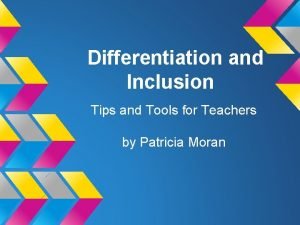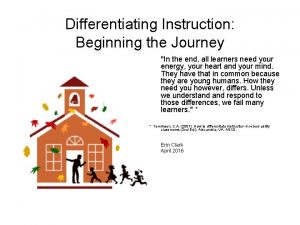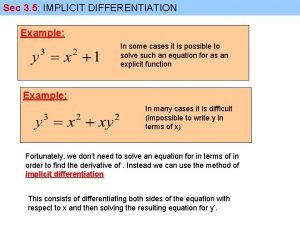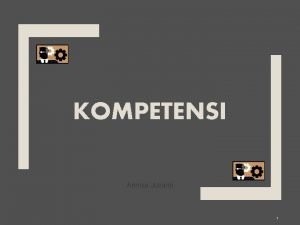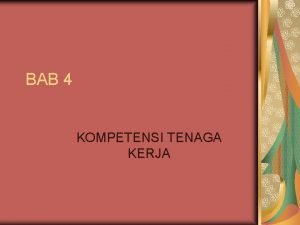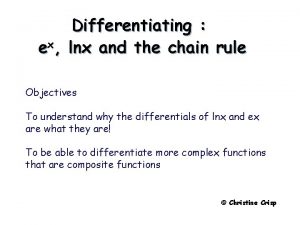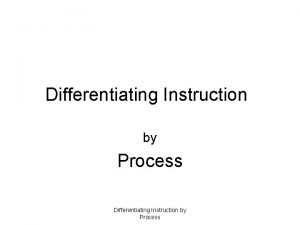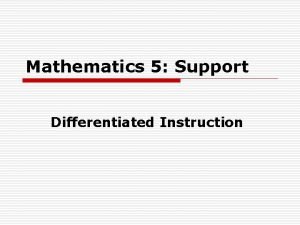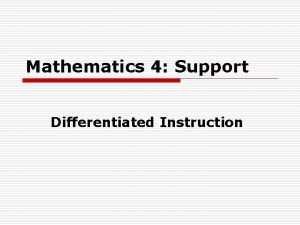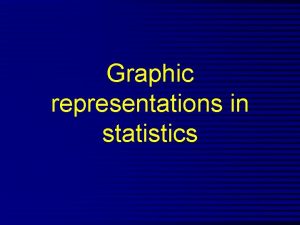Module 3 Differentiating Student Responses to Instruction Graphic











- Slides: 11

Module 3 Differentiating Student Responses to Instruction

Graphic Organizer for CTE in Mixed-Ability Classrooms-Module 3 3. Last Section: Engaging Students 1. Current Module: 4. Next Module: Opportunities for Students with Disabilities Differentiated Instruction 5. Big question: How do we provide choices and different ways of learning core content 6. The Key Concepts 2. Is about: Differentiated Instruction Cognitive Approaches Learning Styles Cooperative Learning 7. Self-test questions 1. How is differentiated instruction different from 2. 3. 4. 5. “watered-down” curricula Name several ways that students can approach core content using Tomlinson’s “Think-Tac-Toe What are the two key criteria for developing cooperative learning projects Why is it important to work in mixed-ability groups? Describe the steps in the “Jigsaw” approach to cooperative learning 8. Unit Schedule 1. Discussion of the importance of differentiated 2. 3. 4. 5. instruction for mixed-ability classrooms Presentation of the “Think Tac Toe” model Discussion of the importance of cooperative learning Presentation of the “Jigsaw” model Group exercise in developing a cooperative learning project

3. A. Differentiated Assignments

Differentiated Assignments n Improves students response to instruction by: n Making it more relevant to student learning goals n Allowing students to approach learning in their own way n Assignments may be differentiated to promote: Different ways of thinking about a concept n Different ways of approaching or implementing a concept n

Think Tac Toe n Developed by Carol Tomlinson (2001) who is a recognized expert in differentiated instruction n Is designed to be aligned with key concepts and standards n Has been applied in a number of ways including cognitive and learning styles approaches

Think Tac Toe method of differentiating learning expression Kinesthetic Knowledge Auditory Whole body games, movement activities, making models, following instructions to make something, setting up experiments list, define, tell, describe, identify, show, label, collect, examine, quote, name, who, when, where interviewing, debating participating on a panel giving oral reports participating in oral discussions of written material Comprehension Core Content Synthesis Summarize, describe, interpret, contrast, predict, associate, distinguish, estimate, discuss, extend information is presented in sequential steps, lessons are structured and teacher-directed goals are clear requirements are spelled out combine, integrate, modify, rearrange, substitute, plan, create, design, invent, what if? , compose, formulate, prepare, generalize, rewrite Visual Evaluation Tactile computer graphics maps, graphs, charts, cartoons, posters, diagrams, graphic organizers, text with a lot of pictures assess, decide, rank, grade, test, measure, recommend, convince, select, judge, explain, discriminate, support, conclude, compare Drawing, playing board games, making dioramas, making models, following instructions to make something

3. B. Cooperative Learning Strategies

Cooperative Learning Strategies n Two criteria n Each member’s effort is required and indispensable to the group n Each member has a unique contribution to make to the joint effort n “Jigsaw approach” a popular method n See http: //olc. spsd. sk. ca/DE/PD/instr/strats/jigsaw

Jigsaw Cooperative Learning n Students are assigned to groups (home) that consist of students with diverse learning styles or needs n Each student is given a different portion of the group’s assignment based on their learning needs n Each student then goes to an “expert” group that focuses on one aspect of the assignment (e. g. , visual, auditory, or other learning approach) n Expert groups discuss how the assignment can be addressed using their expertise (or learning style) n The experts return to their groups (home) to share their approach

Jigsaw Assignment for Hazard Analysis Kinesthetic Knowledge Auditory Develop a demonstration on proper hand washing techniques Define and explain each component of hazard analysis listed under the three key concept areas Discuss hazard analysis and identify frequently asked questions Comprehension Home Group Assignment Synthesis Provide a two paragraph summarization of hazard analysis and why it is important Develop a presentation and manual that addresses the key concepts in hazard analysis Develop a list of rules regarding hazard analysis that could be easily understood by employees Visual Evaluation Tactile Explore the web to find videos and pictures that can be used in the presentation and manual Develop a hazard analysis checklist that can be used to evaluate how well employees are implementing it Obtain examples of chemicals that might be used in the kitchen

GROUP EXERCISE FOR MODULE 3 n Break back into your groups of 4 -6 n Plan to develop a Safety Presentation that includes n n A visual presentation A written presentation A demonstration An oral presentation n Send at least one home group member to the “expert group” tables marked, “visual, written, demonstration, and oral ” n Return to your home group and develop a brief description of how your group will address each of the above areas in your presentation.
 Stagnating intensifying experimenting circumscribing
Stagnating intensifying experimenting circumscribing Differentiating process examples
Differentiating process examples Differentiating process examples
Differentiating process examples Differentiating content
Differentiating content Differentiating acceleration
Differentiating acceleration Inverse sine derivative
Inverse sine derivative Derivative of trigonometric functions
Derivative of trigonometric functions Contoh differentiating competencies
Contoh differentiating competencies Contoh threshold competencies
Contoh threshold competencies Security market indexes
Security market indexes Differentiate from first principles
Differentiate from first principles Security market indicator series
Security market indicator series

